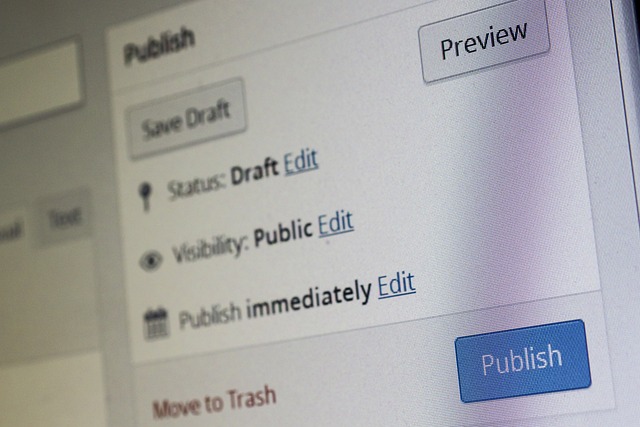Integrating a chatbot into your WordPress site can significantly enhance user engagement and streamline customer interactions. A WordPress chatbot leverages AI and NLP to provide instant, intelligent responses to users' inquiries, improving customer support and personalizing experiences. When choosing a chatbot plugin for your WordPress platform, consider your specific needs—whether it's customer service, sales support, or user engagement—and select a solution with features that align with those goals. The WordPress Plugin Repository offers a variety of chatbot plugins, each with unique functionalities. Evaluate plugins based on compatibility with your existing setup, ease of use, and the quality of customer support. A top-rated option like Chatbot for WordPress by WPBotStudio stands out due to its user-friendly interface, advanced customization options, and regular updates that incorporate AI advancements. For a personalized touch, you can fine-tune your chatbot with specific training data or integrate it with external AI services for enhanced conversational capabilities. Regular testing and monitoring are key to optimizing chatbot performance, ensuring accurate responses and a seamless user experience. By continuously refining the chatbot based on analytics and user feedback, it becomes an indispensable tool for maintaining high standards of customer service and user satisfaction on your WordPress site.
title: “Crafting an Efficient Chatbot for Your WordPress Site: A Step-by-Step Guide”
In today’s digital landscape, where user engagement and real-time interaction are paramount, integrating a chatbot into your WordPress site can significantly enhance user experience. This comprehensive guide demystifies the process of building a WordPress chatbot, from grasping the fundamentals to fine-tuning your bot for peak performance. We’ll explore various chatbot plugins, offer insights on setting up and customizing your chosen tool, and provide tips for ongoing testing and improvement. Whether you’re aiming to answer FAQs, guide users through your site, or provide customer service, mastering the art of a WordPress chatbot is within reach. Dive into the world of conversational automation and elevate your online presence with a chatbot tailored to your needs.
- Understanding the Basics of Chatbots on WordPress
- Evaluating Chatbot Plugins for Your WordPress Site
- Setting Up Your Preferred Chatbot Plugin
- Customizing Your Chatbot's Interactions and Responses
- Testing, Monitoring, and Improving Your WordPress Chatbot
Understanding the Basics of Chatbots on WordPress

To effectively build a chatbot for your WordPress site, it’s crucial to grasp the fundamentals of what a chatbot entails and how it can enhance user engagement and experience. A chatbot on WordPress is essentially an automated program designed to interact with visitors through conversational interfaces, answering their queries in real-time or guiding them through predefined workflows. This technology leverages artificial intelligence (AI) and natural language processing (NLP) to understand user input and provide relevant responses, thereby streamlining customer support and offering personalized experiences.
Before diving into the development process, it’s important to identify the purpose your chatbot will serve on your WordPress platform. Whether it’s for customer service, sales inquiries, or simply to engage visitors, clarifying its role will inform the design and functionality you prioritize. There are several methods to integrate a chatbot into your WordPress site, ranging from using pre-built plugins that can be customized to suit your needs to developing a bespoke chatbot solution with advanced AI capabilities. Regardless of the approach, understanding the integration process, including API connections and data handling, will set a solid foundation for creating an effective chatbot experience on WordPress.
Evaluating Chatbot Plugins for Your WordPress Site

When integrating a chatbot into your WordPress site, evaluating chatbot plugins is a pivotal step in enhancing user engagement and providing automated assistance. The WordPress Plugin Repository offers a plethora of chatbot solutions that vary in functionality, customization options, and integration capabilities. To select the most suitable chatbot plugin for your needs, consider the type of interactions you wish to facilitate with your visitors. Some plugins may specialize in customer service, offering instant support through pre-set responses or AI-driven learning algorithms. Others might be tailored for lead generation, equipped with forms and data collection features to streamline the process of capturing user information.
In assessing these chatbot plugins, prioritize those that align with your specific goals, whether it’s improving customer service, increasing sales conversions, or simply providing a more interactive experience on your site. Check for compatibility with your current WordPress setup, ease of use, and the availability of support should you encounter any issues. Additionally, examine user reviews and feedback to gauge the plugin’s performance and reliability in real-world scenarios. A well-chosen chatbot can significantly enhance user satisfaction and streamline operations on your WordPress site, making it a valuable addition to your digital toolkit.
Setting Up Your Preferred Chatbot Plugin

When integrating a chatbot into your WordPress site, selecting the right plugin is pivotal for delivering an effective user experience. Among the array of available options, Chatbot for WordPress by WPBotStudio stands out as a robust solution. This plugin offers seamless integration with your existing website infrastructure, allowing you to configure and customize your chatbot with ease. Upon installation, navigate to the ‘WPBots’ menu in your WordPress dashboard to access the chatbot’s settings. Here, you can tailor the chatbot’s responses, set up triggers for specific queries, and define the flow of interactions to suit your visitors’ needs. The plugin’s intuitive interface guides you through each step, ensuring that you can implement advanced functionalities like natural language processing without needing extensive programming knowledge.
Furthermore, to enhance user engagement and personalize the chatbot experience, consider leveraging additional features provided by the plugin. You can program the chatbot to answer frequently asked questions, collect user information for follow-up communications, or even integrate it with your customer service team for real-time support. Regular updates ensure that your WordPress chatbot remains up-to-date with the latest in conversational AI technology, providing a consistently sophisticated tool to interact with and assist your website’s visitors. By dedicating time to set up your preferred chatbot plugin carefully, you can significantly improve user interaction and streamline communication on your WordPress site.
Customizing Your Chatbot's Interactions and Responses

When integrating a chatbot into your WordPress site, customizing its interactions and responses is key to providing a tailored user experience. To begin with, WordPress users can leverage plugins designed specifically for chatbot functionality, such as WP-Chatbot or Tidio Chat. These tools offer a range of pre-set responses and conversation flows that can be easily adjusted to fit your website’s needs. By utilizing the plugin’s interface, you can modify greetings, answers, and even the chatbot’s personality to align with your brand’s voice. Additionally, advanced settings allow for conditional logic, enabling the chatbot to process user inputs and provide contextually relevant responses. This personalization ensures that each interaction is not only efficient but also engaging, enhancing the overall user experience on your site.
Furthermore, for a more sophisticated approach, developers can tap into the chatbot’s API to implement custom functionalities. This programming interface allows for integration with external services like OpenAI’s GPT-3 or Dialogflow, which can significantly expand the chatbot’s conversational capabilities. By integrating these AI models, your WordPress chatbot can handle a wider array of queries and deliver more nuanced and accurate responses. Customizing the machine learning model’s training data can further refine its understanding of your specific domain or industry, ensuring that the chatbot not only communicates effectively but also provides value-added information to users. This level of customization is essential for creating a chatbot that truly represents your brand and resonates with your audience on WordPress.
Testing, Monitoring, and Improving Your WordPress Chatbot

To ensure your WordPress chatbot functions optimally, it is crucial to implement a robust testing phase. This involves conducting thorough checks to confirm that the chatbot’s responses are accurate and relevant across various scenarios. Testing should encompass a range of inputs to validate the chatbot’s ability to handle different types of queries efficiently. Utilize tools within your WordPress environment, such as the built-in debugging features, to monitor the chatbot’s performance in real-time. This allows for immediate identification and resolution of any issues.
After deployment, continuous monitoring is key to maintaining a high-quality user experience. Keep an eye on metrics like response accuracy, conversation flow, and user satisfaction. Employ analytics tools to track interactions and identify patterns or common questions that can inform future improvements. Based on this data, iteratively refine your chatbot’s scripts and responses to enhance its effectiveness. Regular updates will not only improve the chatbot’s performance but also ensure it remains aligned with your evolving needs and user expectations. By adopting a proactive approach to testing, monitoring, and improving your WordPress chatbot, you can provide valuable assistance to your users while leveraging the power of artificial intelligence to streamline communication on your site.
In conclusion, integrating a chatbot into your WordPress site can significantly enhance user engagement and streamline customer service. By understanding the basics of chatbots, evaluating suitable plugins like WP-Chatbot or Tidio Chat, setting them up effectively, and personalizing interactions to cater to your audience’s needs, you can create an intelligent conversational agent that operates seamlessly within your WordPress environment. Testing and continuous monitoring are key to refining the chatbot’s performance, ensuring it serves as a valuable tool for your site. Remember to explore the various features each plugin offers to optimize the chatbot’s capabilities. With these steps, you can effectively implement a WordPress chatbot that aligns with your objectives and enriches the user experience on your website.
